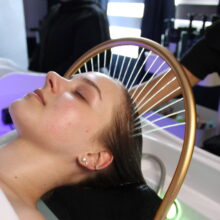2013 Top 10 Global Spa and Wellness Trends
- Published: Friday, November 1st 2013
- in Living Well
TOP 10 GLOBAL SPA AND WELLNESS TRENDS FOR 2013
Each year a team of research analysts develops the Spafinder Trend Report. The in-depth forecast is developed from ongoing surveys with the Spafinder Network, which consists of thousands of spa, wellness, fitness and beauty providers, thousands of travel agents and hundreds of thousands of consumers. We conduct ongoing interviews with top industry stakeholders, review current research, articles and case studies and our team of editors and experts visits spa and wellness establishments regularly.
Our goal is to get the industry, and the consumer, thinking further ahead and to provide data and analysis to support each trend.
When we unveiled our first trend forecast a decade ago, the industry focus was on beauty and pampering, medical spas were a new concept and the thought of spas as centers for wellness—and the idea of wellness tourism—was just emerging.
In this year’s report we forecast a dramatically changed world where the industry fully embraces its role in helping people find wellness modalities that can transform lives, from “Healthy Hotels” to “Earthing” to “Spa-Genomics.”
But it’s also a world where men will increasingly seek anti-aging treatments at the same medical spas they might not have considered just 10 years ago.
1. Healthy Hotels
The very concepts of a “vacation” and business travel have long been associated with riotous excess: too much eating, drinking and too little sleep in the stately pleasure palace that is a hotel. This century-old model has left too many travelers less healthy when they check out than when they check in. But, with a global stress and chronic disease epidemic intensifying—and more people stressed out 24/7—what constitutes a true “vacation” and “hospitality” is now being rewritten. In 2013 (and beyond) far more hotels will serve up health-focused guest experiences and “wellness everywhere” environments bent on delivering much-needed revitalization for people who simply can no longer afford “the old travel.”
2. The Mindfulness Massage…and More
Swedish, Thai, shiatsu, hot stone…make way for “the mindfulness massage” in 2013, a creative blend of two effective approaches—mindfulness techniques and bodywork—that when combined can have a uniquely positive, profound impact on people’s stress levels, emotions and brains.
3. Earthing
Experts point out that human brains and bodies evolved to thrive in natural environments: to chase and be chased, to work the earth, and so on. Now, relatively suddenly, most people are severely disconnected from nature, living in concrete jungles and spending their lives in front of various screens. The fallout: “Nature Deficit Disorder,”¹ a term describing a range of physical and emotional ailments afflicting people cut off from the natural world.
4. Spa-Genomics (Telomeres and Beyond)
Human beings have 30,000 genes and a three billion-letter DNA code. And the future of medicine is mining that byzantine information to identify new, breakthrough medical approaches, and to support a new age of more predictive, personalized—what is being called “precision”—medicine specifically grounded in an individual’s unique genetic profile. Genomic science and testing is moving fast: The first human genome sequence was only completed a decade ago, but Scientific American recently argued it wouldn’t be long before doctors could offer individual genome sequencing for roughly $1,000.
5. Authentic Ayurveda and Other Ancient Revivals
Spas have always broadcast the ancient pedigrees of their healing practices, whether hydrotherapy circuits originating in ancient Rome or millennia-old yoga traditions. Too often, however, a “lite” version got served up (a few Ayurvedic touches here, a steam room dubbed a “hammam” there). And, typically, all this venerable ancientness got played out in a modern, blandly beige space.
6. Color Self-Expression
Beauty has taken a bold, theatrical turn of late, with the old “Barbie-doll prettiness”—a “healthy glow,” natural highlights, a dab of lip gloss and a French manicure—under radical revision. In 2013 the envelope-pushing trend will only intensify. And from hair to nails, this beauty “self-expression” wave will get most intensely played out around COLOR.
7. Inclusive Wellness (Rethinking “Disability”)
Many new demographics have been warmly welcomed by spas: Baby Boomers, men, teens, little kids, the LGBT community—even babies. While spas’ original DNA is healing, there has been sparse programming for the growing ranks of people with disabilities.
8. Label-Conscious Fitness
“Name-brand” fitness has been around for decades, but fitness programs, often branded by celebrities and fitness gurus, have exploded (and receded) as media-driven tastes and fashion changed over the years. But today being fit is the new luxury, and the manic mechanisms of chasing the new, the “in”, and what the insider elite is doing, have infused the fitness world with a distinct “haute couture” vibe, with new methods and classes spawning like fashion brands—in every imaginable style.
9. Men: From Barbers to “Brotox”
When Spafinder first identified the upsurge in men hitting spas (Trend Reports 2001, 2005) the focus was on new “macho” spas, where post-golf rubdowns and old-fashioned shaves took place in clubby, brandy-sniftering-and-sports-watching environments…aggressively assuaging all fears that “what was going on” had anything to do with feminized beauty. If the spa-man headlines for the last decade have been all about rugged relaxation and rejuvenation, you might say that the big story now is Restylane and Juvederm.
10. Where the Jobs Are
The world has a nasty jobs problem: an unemployment backlog of 210 million people worldwide and 30 million jobs lost since the 2008 recession.¹ Economists argue that 400 million new jobs will need to be created over the next decade² to avoid this crisis from worsening. The cry for “jobs, jobs, jobs” dominates political discussions, as it did, for example, in the recent U.S. presidential election. But while “high-tech” is the much-discussed job-creation savior, there is too little recognition of the opportunities within the growing, talent-needy, “high-touch” spa and wellness industries.



